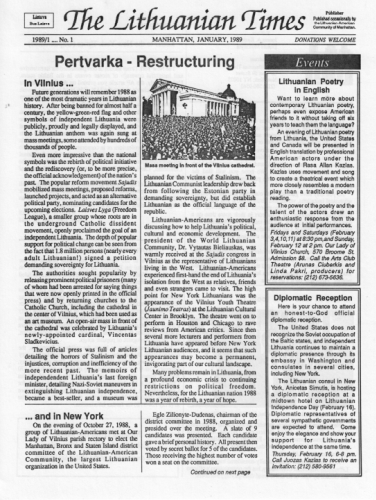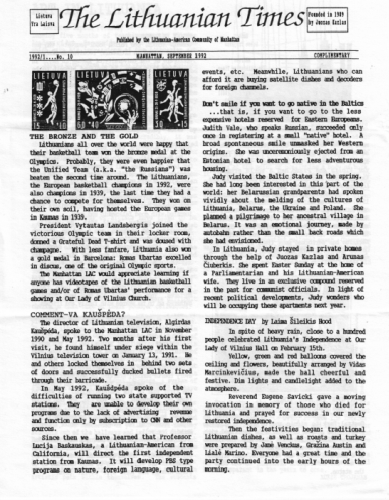
There were ten issues of The Lithuanian Times. Juozas Algimantas Kazlas founded the publication and edited the first 9 issues, from January 1989 to September 1991. Aukse Trojanas was the editor of the last issue, in September 1992.
The Lithuanian Times was intended primarily for New York and especially Manhattan Lithuanians, many of whom were young and middle-aged professionals who had arrived from other parts of the U.S. The title was a deliberate imitation of The New York Times, and the contents provided quick information to busy people in English with an occasional dash of humor. Each issue consisted of two sides of one sheet of paper of standard American size. In addition to making it a compact source of information, this format also made it easy to duplicate and to mail. Duplication was often done by Kazlas using a photocopy machine at work after hours, at the Shearson-Lehman financial corporation on Wall St., or in the office of a lawyer friend. With his wife, theatre director, actor and instructor Rasa Allan Kazlas, they would stuff several hundred copies of the newsletter into envelopes, attach stamps and mail them.
Desktop publishing software had just become availabe. Kazlas used the Ventura program to create the logo of the Columns of Gediminas (Gedimino stulpai) with the Manhattan skyline in the background and to lay out each issue with text and photos. Most of the material was written by Kazlas; occasional contributors were clearly identified. The publication was in English because it was quicker and easier to read for Lithuanians who grew up in America (and for Kazlas to write, since he had never attended a Lithuanian school), and could be shared with friends who did not understand Lithuanian.

1989-1991 were exciting, historic years. In addition to the growing actions in Lithuania to regain independence, for the first time there were many visitors from Lithuania to the U.S., and a newsletter was the best way to inform and organize political and other activities in New York, New Jersey and Connecticut, especially among younger Lithuanians who may have been out of touch with established Lithuanian community organizations and publications. (At that time, Kazlas was also a chairman of the Manhattan District of the Lithuanian American Community). Occasionally flyers (skrajutės) announcing coming events or organizing political action were included in the envelope with the newsletter or mailed separately between issues.

The Lithuanian Times received a warm welcome from many readers, including some donations to help cover publication and distribution costs. (The newsletter was provided to its readers at no cost.) Some even asked that it be sent to their friends in distant states. However, Lithuania regained its independence and the political crisis was over. The production of a newsletter by one or two unpaid individuals in their spare time was not a sustainable long-term foundation for a publication. The individuals involved became busy with other activities and responsibilities, and The Lithuanian Times ceased publication.
Juozas A. Kazlas, Ph.D.
June 8, 2020